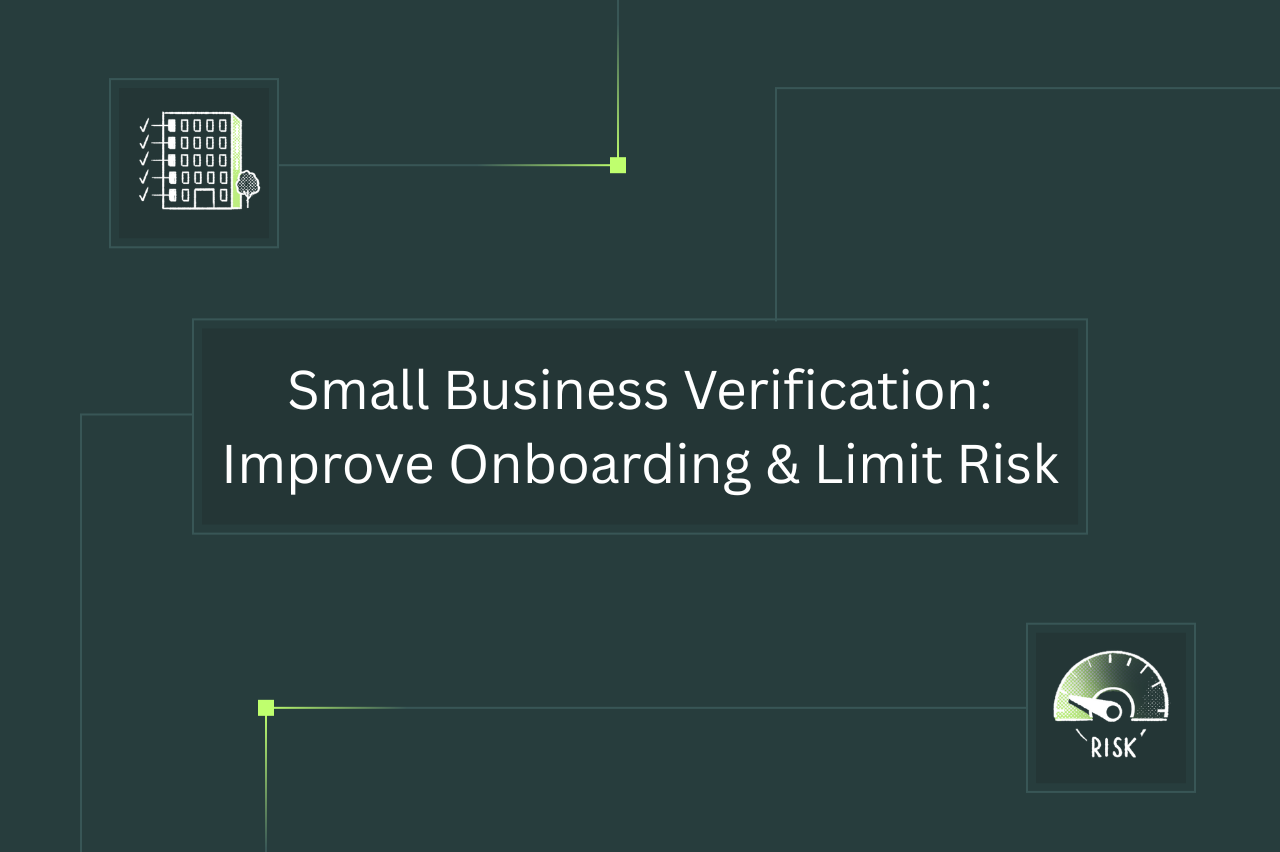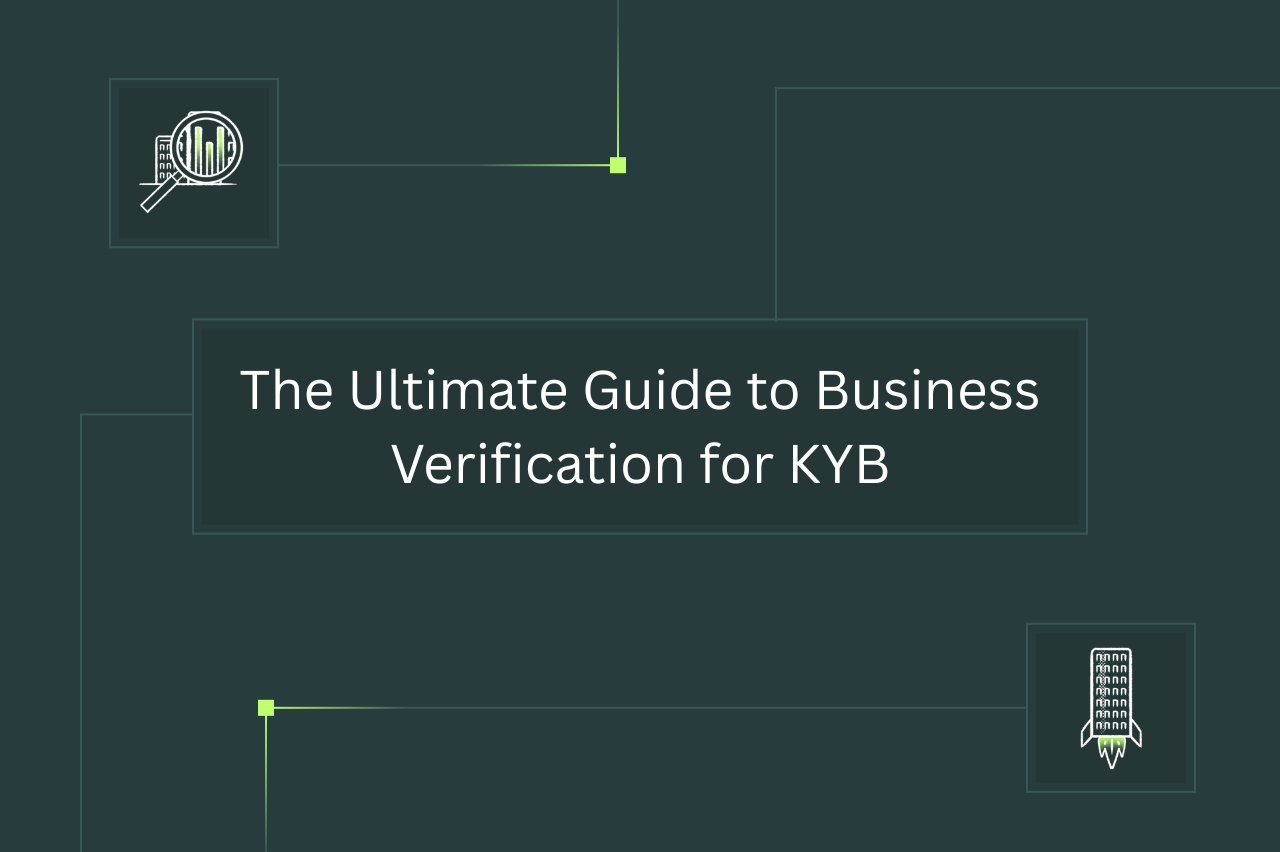In brief:
- Small business verification involves running KYB & KYC processes on small businesses to ensure their information is authentic and correct.
- Companies in many industries need to verify small businesses that they work with to comply with legal requirements, assess the risk of working with said businesses, accurately set terms of loans and insurance policies, and ultimately avoid being defrauded.
- To verify small businesses, companies need to authenticate information on the business and its owners, search out risk-related information about the business and its owners to develop a risk profile for the business, and then monitor the business’s activity and periodically review its risk profile.
As of 2023, there were over 32 million small businesses in the U.S. alone. And all of those small businesses are, at some point, going to need loans or other financial services to keep their operations running. However, some small businesses may try to take advantage of the system to get more than what they’re entitled to. Others may pretend to be small businesses, but are actually criminals looking to steal or illegally move money.
How do you weed these bad actors out? You have to know exactly who you’re dealing with. That’s why small business verification is not only legally required in many places, but also a critical part of an effective risk management policy.
This article explains further by looking at how small business fraud happens, and which industries are at risk. Then it outlines how verifying small businesses protects your financial service or fintech, as well as how to carry out the process effectively.
- What is small business verification & what does it entail?
- Who needs to perform small business verification?
- Types of small business fraud & how they occur
- 5 benefits of performing small business verification prior to onboarding
- How to perform small business verification
To start, we define what small business verification is and what it can involve.
Small business verification is the process of confirming a small business’s identity, ownership, and risk-related information against trustworthy records. This allows for ensuring a small business is authentic, representing itself truthfully, operating lawfully, and not overly risky to deal with.
Small business verification can be tricky because there are many different classifications. They are generally classified as any businesses with fewer than 500 employees, but that could include LLCs, partnerships, or sole proprietorships.
Some newer businesses also don’t have a well established credit file or a lot of data you can base your decision off of. It’s very difficult assess whether a thin file business is just that - a business with a thin credit file - or if their lack of information should lead to the conclusion that they aren’t a legitimate business.
Basically, any kind of company that could have financial dealings with small businesses needs to verify those small businesses before onboarding them.
Some of the most common examples include:
- Fintechs & Financial Services – Financial institutions need to know they’re dealing with legitimate small businesses that aren’t being used to steal or launder money. This is especially important with fintechs, as they often boast lower costs and more accommodating onboarding processes that make them attractive to small businesses.
- Lenders – Lenders need to be sure small businesses applying for loans aren't being used as covers for someone to steal money or to secure a loan they wouldn’t normally qualify for.
- Insurers – Similar to lenders, insurers need to be confident that small businesses applying for coverage aren’t being used to hide an entity’s true risk level or make fraudulent claims.
- Marketplace Administrators – Marketplaces involve small businesses by nature, so administrators have to ensure the small businesses that apply are trustworthy. Otherwise, consumers or the marketplace itself could be defrauded, damaging the marketplace’s reputation in the process.
- Payment Processors – Companies that provide payment solutions for small businesses need to protect themselves as well. They need to know they aren’t potentially enabling phony or otherwise dishonest businesses to commit fraud.
- Crypto Platforms – Cryptocurrency transactions are, by nature, semi-anonymous and tamper-resistant. So being able to trust that customers (including small businesses) are who they claim to be and will deal fairly is especially important in this industry.
Onboard — and underwrite — small businesses with confidence so you can speed up the digital lending process and enable businesses to achieve success. Our Credit Assessment product demo shows you how to get it done using Middesk.
{{gated-content-block="/events/productdemo-creditassessment-august-2025"}}
Small business fraud tends to follow the larger patterns of the three main categories of fraud: first-party, second-party, and third-party.
- First-party – A business customer commits fraud by misrepresenting their identity details, financial situation, and/or ownership structure.
- Second-party – An entity willingly allows a business customer to use their identity and/or account information fraudulently, or carries out financial transactions while illegally concealing they’re doing so on behalf of the business customer.
- Third-party – An entity commits fraud by pretending to be a business customer, either by hijacking a legitimate business’s account(s) or by using fake, stolen, or synthetic identity information to appear as if they’re a legitimate business.
Verifying small businesses before onboarding them is an important step to take for a number of reasons. Here are 5 of them:
1. Avoid legal trouble
As of 2016, all companies in the U.S. classified as “financial institutions” under the Bank Secrecy Act are legally required to verify the identities of any business they deal with (including the identities of the business’s beneficial owners). That means failing to have an adequate small business verification program in place can result in fines, suspensions, criminal charges, and other punitive actions from regulators.
2. Ensure you’re not dealing with fake entities
Criminals can create fake personas and business profiles in order to steal or launder money. They may even include ID information stolen from real companies to make their forgery look more legitimate. Verifying small businesses before onboarding them allows you to be certain you’re dealing with people and businesses who actually exist.
3. Assess risk related to dealing with particular businesses
Even supposedly legitimate businesses can have warning signs that they may have been (or become) involved in financial (or other) crime. These include liens, bankruptcies, or litigations. Verifying their information beforehand can help you determine how likely they may cheat you or send money to the wrong people.
4. Loan to or underwrite businesses with more certainty
These same risk signals are especially critical for lenders and insurers. They are key pieces of information in determining how much a loan or policy should be worth, as well as what the other terms of the agreement should be. Verifying a business applying for a loan or insurance ahead of time ensures lenders and insurers have accurate data for these purposes.
5. Streamline onboarding and KYB workflows
Making sure a business’s information is authentic and correct upfront ultimately makes the onboarding process go smoother, since you’re getting things right the first time. It also makes ongoing monitoring and risk assessment easier, since you’ll have all of the business’s accurate risk-related information at your fingertips. You can see where the business’s main risks lie, as well as who else in their network of connections could present risks.
Learn more about how Middesk accelerates business onboarding for a variety of lenders, banks, neobanks, and other financial institutions.
In the U.S., FinCEN’s CDD Final Rule lays the groundwork for how to verify the legitimacy of (small) businesses. Many of these steps can be expedited – even automated – by small business verification services such as Middesk.
1. Collect and verify the business’s ID information
Financial institutions are required to collect and verify certain pieces of information about businesses. These include, at minimum:
- Legal name
- Alternative trade names (e.g. “doing business as”)
- Registered address
- Operating address(es)
- Taxpayer Identification Number (TIN); usually an EIN
- Business registration documentation
- Industry-specific licensing documentation (if applicable)
If a small business is a sole proprietorship, some of this information may not be available as it isn’t required to operate a sole proprietorship. In that case, you may have to just move on to the next step with as much of the above information as you can get.
While businesses can acquire these manually in many cases, it’s extremely tedious to do so and widely prone to human error. Instead, organizations can use TIN matching software that can help companies determine if a company is legitimate early in the funnel and acquire business formation documents to validate a company (and their members) are who they say they are.
2. Identify and authenticate the business’s beneficial owners
Another requirement is knowing who ultimately owns and controls the business (i.e. they own at least 25% of shares or exercise at least 25% of voting rights). Authenticating Ultimate Beneficial Owners (UBOs) ensures that the business isn’t being used to funnel money into the hands of criminals.
You must find out who the beneficial owners of the business are and collect the following information from them, at minimum:
- Full name
- Home address
- Date of birth
- Government-issued ID number
Again, you may have to focus more heavily on this step if dealing with a sole proprietorship, as the business may have little registered information available. So your verification process will be more akin to KYC than KYB.
{{related-content-block="/blog/how-why-to-identify-a-companys-ultimate-beneficial-owner-ubo"}}
3. Perform due diligence and assess risk
Once you’ve confirmed the business is what its representative(s) claim it to be, and its owners are who they claim to be, you have to next turn to risk assessment. This means checking for signals that a business or its owners have been involved in financial crime in the past, or may become involved in the future. In other words, conducting Customer Due Diligence (CDD).
Things to look for regarding the business and its owners include:
- High net worth
- Presence on a sanctions list or other financial watchlist
- Previous criminal history
- An owner is (or has been) a politically exposed person (PEP)
- Suspicious prior transactions or transaction patterns
- Presence of UCC or federal/state tax lien
- Bankruptcy or litigation history
- Negative coverage in news media
These will help you put together a risk profile for the business, which will help you decide whether or not to continue pursuing the relationship.
4. Administer further due diligence if necessary
If a business or its owners present a significantly high risk level, but you still want to potentially move forward with them, you should do some extra investigative work in the form of a Customer Identification Program (CIP). This can include:
- Identifying what other companies or people are associated with the business or its owners, and verifying their identities
- Tracing where the business’s income comes from, and figuring out if its value lines up with the value of real assets the business owns
- Inspecting some of the business’s prior transactions to determine how they were carried out, who they were with, why they were done, how long they took, and what each party got out of them
- Visiting the business in person and requesting hard copies of ID documents
Enhanced Due Diligence (EDD), as this is known, will provide an even more granular picture of how risky a business is to deal with. Then you can make a more definite decision on whether or not a business is worth forming (or maintaining) a relationship with.
5. Stay vigilant with ongoing monitoring and due diligence reviews
Onboarding a small business isn’t the end of the verification process. A business’s scenario can change over time, especially if the business scales up and its ownership structure becomes more complex. Its risk factors could rise or lower in prominence, or new risk signals could appear – even among the business’s owners.
That’s why you have to monitor a small business’s activity and circumstances for potential changes to the business’s risk profile. At some point, you may have to reconduct due diligence processes on the business to evaluate if its risk level has changed enough to loosen or tighten oversight, or even terminate the relationship.
Modern small businesses expect smoother customer experiences from financial institutions. However, this sometimes results in a compromise on authenticating and vetting customers – one that criminals are readily exploiting by posing as fake small businesses or impersonating real ones.
You need the right small business verification service to strike the proper balance for KYB: a process that’s as comprehensive as it is fast and hassle-free. In other words, you need Middesk. With our direct links to Secretary of State portals in every U.S. state offering 100% coverage on registered U.S. businesses, we can provide the data and infrastructure you need to onboard and maintain customers both quickly and securely.
Many organizations fear that small business verification will be a challenging hurdle to overcome. Schedule a demo with our sales team to find out why Middesk has more than enough signals to enable you to verify small businesses.










